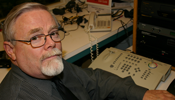
BIOGRAPHY
John Street is an Instructional Program Manager in the Department of Anesthesiology at the University of Wisconsin School of Medicine and Public Health. John taught high school social studies for 15 years and earned his MA in Educational Administration at Villanova University. He is currently working on his dissertation in Educational Leadership and Policy Analysis here at the University of Wisconsin-Madison. His dissertation focuses on the faculty evaluation of anesthesiology residents� clinical competence.
Among his other duties in the Department of Anesthesiology, John works with the high-fidelity simulation program, which provides an authentic operating room learning environment for medical students and anesthesiology residents. The rising demand for accountability in healthcare and the accelerating growth of medical knowledge and technology will eventually make high-fidelity simulation an indispensable component in the training and evaluation of physicians.
Although John has little direct experience with online gaming, his two sons frequently share their extensive online experiences. These vicarious gaming experiences combined with work in the department�s simulation lab have convinced John that gaming and simulation are highly effective (yet under-utilized) educational tools for all levels of learning.
ABSTRACT
Computer-Based Simulations for Medical Students in Anesthesiology
Medical schools today strive to keep pace with the accelerating growth of medical knowledge and technology. Since lengthening the years of medical education is unlikely, medical schools must find ways to teach more effectively. Fortunately, the rapid advance of technology has provided effective computer-based simulators for medical education. We are using this type of simulation with medical students in our anesthesiology clerkship. Students work collaboratively in small groups to manage an anesthesia patient in a computer-based simulation.
The Anesthesia Simulator uses mathematical models of physiology and pharmacology to present authentic patient cases. The patient�s vital signs (heart rate, respiration, temperature, blood pressure and oxygen saturation) are displayed throughout the simulated case. The student has complete control over the management of the case. The program allows the medical students to communicate with the virtual surgeon and choose from a number of treatment options including: airway management techniques, drug administration, monitors to be employed, and fluids to be administered. As the case progresses and students make patient management decisions they are able to see how those decisions would play out in the operating room. Studies have found that similar computer-based simulations are effective educational tools (1-4). A key benefit of medical simulation is that students can practice their skills repeatedly without ever compromising a patient�s safety.
The Anesthesia Simulator is a learner-centered tool. The authenticity of the simulator provides an opportunity for students to integrate their medical knowledge, clinical reasoning, and patient management techniques outside of the clinical setting. The authenticity and level of complexity in the simulator scenarios facilitates students� understanding of the abstract concepts underlying clinical practice. Further, students can use the simulator to focus on their particular learning needs. Studies have demonstrated that deliberate practice accelerates the acquisition of expertise (5-7) and the portability of the simulator program allows students to gain this deliberate practice at their convenience.
The simulator is a flexible tool that provides valuable teaching options. Instructors can choose from several patients and initiate any one of dozens of clinical procedures for students to manage. Case difficulty can be adjusted by choosing to run a standard case or have a random complication arise. Also, the simulation can be run real-time or automatically advanced to the next significant event or teaching point. Since students� clinical experiences in the operating rooms vary considerably during the clerkship, the simulator helps the instructor ensure that all students cover essential course material.
Well-designed simulation has the potential to make teaching and learning more precise and effective. We plan to catalog the most common learning problems students encounter during the simulations and then adjust course activities to address those areas. We believe this computer-based simulation will prove to be a valuable complement to other simulation efforts in our department. Individuals attending our presentation will have the opportunity to run the simulation program.
References
- Schwid HA, Rooke GA, Michalowski P, Ross BK. (2001). Screen-based anesthesia simulation with debriefing improves performance in a mannequin-based anesthesia simulator. Teaching and Learning in Medicine, 3, 92-96.
- Issenberg, S.B., Petrusa, E.R., McGaghie, W.C., Felner, J.M., Waugh, R.A., Nash, I.S. (1999). Effectiveness of a computer-based system to teach bedside cardiology. Academic Medicine, 74, S93-S95.
- Issenberg, S.B., McGaghie, W.C., Brown, D.D., Mayer, J.W., Gessner, I.H., Hart I.R. (2000). Development of multimedia computer-based measures of clinical skills in bedside cardiology.(pp. 821-29). In: D. E. Melnick, Ed. The Eighth International Ottawa Conference on Medical Education and Assessment Proceedings. Evolving Assessment: Protecting the Human Dimension. Philadelphia: National Board of Medical Examiners..
- Nyssen, A. S., Larbuisson, R., Janssens, M., Pendeville, P., Mayne, A. (2002) A comparison of the training value of two types of anesthesia simulators: Computer screen-based and mannequin-based simulators, Anesthesia and Analgesia, 94, 1560-1565.
- Ericsson, K.A., Krampe, R.T., Tesch-Romer, C. (1993). The role of deliberate practice in the acquisition of expert performance. Psychological Review, 100, 363-406.
- Ericsson, K.A., Charness, N. (1994). Expert performance: Its structure and acquisition. American Psychologist, 49, 725-47.
- Ericsson, K.A., Lehmann, A.C. (1996). Expert and exceptional performance: Evidence of maximal adaptation to task constraints. Annual Review of Psychology, 47, 273-305.